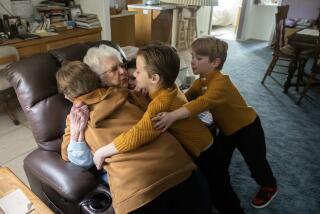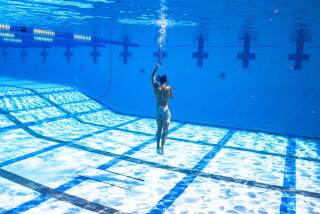Aquatots Puts Arthritic Children Into the Swim
- Share via
Two months ago the pain in 4-year-old Kimberly Barnard’s joints was so bad she couldn’t even get out of bed.
“She just could not walk; we literally carried her for two days,” said Jim Barnard, Kimberly’s father. “When she has attacks like that, it’s very frightening. You can actually feel the heat in the joints. They feel warm to the touch.”
The Santa Ana girl was diagnosed with juvenile rheumatoid arthritis at the age of 2.
Watching Kimberly move about freely in a swimming pool, however, an observer finds it hard to imagine she must take 10 children’s aspirin a day to keep her arthritis pain to a minimum.
But that was the case one morning last week in what might seem an unlikely setting: the heated swimming pool at the Sisters of St. Joseph of Orange convent.
That’s where Kimberly and about a dozen other young arthritis patients have been meeting twice a week since mid-July when St. Joseph Hospital in Orange began its Aquatots program.
The four-week pilot program is offered in cooperation with the Arthritis Clinic of Childrens Hospital of Orange County (CHOC) and funded by a grant from the Arthritis Foundation.
The free program provides two hourlong sessions a week for 2- to 5-year-olds and 6- to 10-year-olds. Although Aquatots is designed to stretch tense muscles and encourage movement of individual joints, the emphasis is on fun.
“Not only is it beneficial for her with therapy, but she gets to be with other children with the same affliction,” said Barnard, watching Kimberly and his wife, Cindy, in the pool.
“My grandparents--Kimberly’s great-grandparents--refuse to believe she even has arthritis,” observed Barnard. “They’re convinced it’s an old people’s disease. I think the general public would be appalled to know 100,000 children are afflicted with juvenile rheumatoid arthritis.”
Actually, the Arthritis Foundation estimates that at least 250,000 children nationwide suffer from juvenile rheumatoid arthritis, a chronic disease that primarily attacks the joints, causing inflammation, swelling and pain.
The benefits of the Aquatots program are basically the same as those for adults in the Arthritis Foundation’s adult swimming program, the whimsically titled “Twinges in the Hinges.”
“With the kids, we have the added benefit of being able to use play and games,” said Diane Barrows, an occupational therapist at St. Joseph Hospital who conducts the Aquatots swim classes.
Because water is a non-weight-bearing medium, Barrows said, “it eases the pain and they can move freer with the water. The pain sensation is blocked off by the warmth of the water, the sensation of the turbulence and the movement they do in the water. We’re trying to eliminate the pain so we can work on the joint range of motion and also work on strengthening the muscles.
“The idea was to try and provide this environment so they’d have the opportunity to express themselves with movement--with the fear of pain decreased.”
Barrows said children with severe cases of rheumatoid arthritis typically tend to back off when they’re playing for fear of falling down or being pushed, thus causing further pain or joint injuries.
“In this environment,” she said, “a lot of that fear is gone.”
‘Children Are Looser’
Barrows and the children’s mothers also have noticed a residual effect after the children get out of the pool.
“You find the children are looser, more relaxed and have less pain following the exercise program,” said Barrows. “Another important thing is they feel good about themselves: They’re doing an activity that’s fun.”
Dr. Christy Sandborg, pediatric rheumatologist at the CHOC Arthritis Clinic, lauds the “social and therapeutic” benefits of the Aquatots program, which she describes as “excellent.”
Sandborg estimates that 500 to 900 children in Orange County could potentially be affected by arthritis. Between 150 to 200 of those children go to the CHOC Arthritis Clinic, which is the only multidisciplinary clinic in Orange County for children with arthritis and related diseases.
Noting that the cause of arthritis is unknown, Sandborg said the disease affects children as young as 1-year-old.
“There are several types of arthritis in children,” she explained. “Some can affect only one or two joints; other types can affect many joints.” In addition to inflammation of the joints, she said, patients may develop fatigue, rashes, anemia and severe fevers.
Sandborg said treatment depends on the severity of the arthritis and may range from aspirin and related drugs to intensive medical therapy such as using gold salts and other advanced drugs.
Although arthritis affects a minority of child patients “quite severely,” Sandborg said, “the outcome for the majority of children is very good. As time goes on, things get better. They may have some restrictions but, by and large, they can look forward to a normal life style.”
Sandborg emphasized that “physical therapy, which is what the Aquatots program is, is a very essential part of the program for any child with arthritis. One of the key points is that getting little children to exercise is difficult. One has to make it fun. Children often love water, so it’s a real good medium for getting them to do what they need to do.”
Parents with children in the program seem to agree.
Looks Forward to Class
“She loves the class and looks forward to it,” said Diana Haney of Fountain Valley whose 9-year-old daughter, Tiffany, was diagnosed with juvenile rheumatoid arthritis in January.
Although medication has helped, Haney said Tiffany still limps occasionally and must curtail or eliminate normal childhood activities such as running or roller-skating.
But the swimming class “has been a help,” said Haney. “I’ve noticed that when she gets home she does the exercises she does in the pool. She feels a lot better, I think.”
“It’s helped a lot,” agreed Lynda Searcy of Garden Grove, whose 10-year-old son, Cary, has had arthritis since he was 8. “He moves around a little better, especially afterwards. You can tell he doesn’t mind walking back to the car. He’s really excited about the class.”
Although the Arthritis Foundation grant for Aquatots only provides funding for the four-week pilot program, Barrows said they are looking into the possibility of extending it.
Continuing on Their Own
“We’ve had a lot of moms say they want to continue it,” she said, adding that many of the parents are continuing the aquatic exercises with their children on their own.
Indeed, the Barnards take Kimberly into the pool and Jacuzzi at their condominium complex almost daily.
“We do arm and wrist extensions as exercises,” said Barnard, explaining that Kimberly’s “primary joint affliction has been her elbows and wrists. She has no permanent joint restriction at this time.
“Generally speaking, she does very well, but there’s that one day in 10 where, just like elderly people, she wakes up with problems like they do: She gets up stiff and is wobbly when she walks.”
And yet, Barnard said, Kimberly also takes swimming lessons and ballet at the day-care school she attends.
“The doctors say let her do as much as she can,” he said, gazing at his petite daughter working out in the pool with Barrows.
“Good girl! Pull those legs together,” said Barrows, supporting Kimberly on her back as the little girl in the purple bathing suit made scissor motions through the water with her legs.
“Good! Good! All right!”
More to Read
Sign up for Essential California
The most important California stories and recommendations in your inbox every morning.
You may occasionally receive promotional content from the Los Angeles Times.










